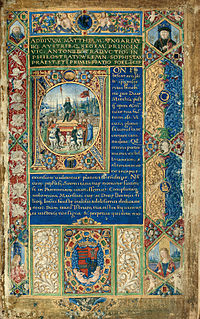Siege of Vienna (1485)
| Siege of Vienna | |||||||
|---|---|---|---|---|---|---|---|
| Part of Austrian-Hungarian War (1477-1488) | |||||||
 Matthias marching into Vienna |
|||||||
|
|||||||
| Belligerents | |||||||
|
|
|
||||||
| Commanders and leaders | |||||||
| Hanns von Wulfestorff Caspar von Lamberg Bartholomeus von Starhemberg Andreas Gall Ladislaus Prager Alexander Schiffer Tiburtius von Linzendorf Leonhard Fruhmann Johann Karrer |
Matthias Corvinus Peter Geréb de Vingard Stephen Zápolya Stephen V Báthory Laurence of Ilok |
||||||
| Units involved | |||||||
| Imperial Army | Black Army of Hungary | ||||||
| Strength | |||||||
| 2,000 foot soldiers 1,000 cavalry 20,000 civilians Reinforcements: 200 cavalry 300 fusiliers 60 archers |
10,000 foot soldiers 18,000 cavalry |
||||||
The Siege of Vienna was a decisive siege of the Austrian–Hungarian War in 1485. It was a consequence of the ongoing conflict between Frederick III and Matthias Corvinus. The fall of Vienna meant its merging to Hungary from 1485 to 1490. Matthias Corvinus also moved his royal court to the newly occupied city.
In the year 1483–84 Vienna was already being cut off from the Holy Roman Empire due to the fact that its concentric defensive strongholds, including Korneuburg, Bruck, Hainburg, and later Kaiserebersdorf, had all fallen. One of the most important engagements was the Battle of Leitzersdorf, which made the next year's siege possible. The city was ravaged by famine, although the Emperor Frederick III did succeed in sending in some vital supplies with a breakthrough to the city by sixteen vessels on the Danube. On 15 January, Matthias called on the city to surrender, but Captain von Wulfestorff refused to do so, in the hope that an Imperial relief force would arrive in time. The blockade was fully in place as soon as Matthias attacked Kaiserebersdorf, where he became the target of an assassination attempt when a cannonball nearly killed him. Matthias suspected treachery, as the accuracy of the shot had been too precise to have come from a long distance cannon—only someone who knew the whereabouts of the King would have been able to come so near to killing him. He accused Jaroslav von Boskowitz und Černahora, the brother of his mercenary Captain Tobias von Boskowitz and Černahora, of having been bribed to turn against the king. Jaroslav was summarily beheaded, without being given any chance to clear his name. These latest turn of events angered his brother Tobias to the point that he ended up returning to the service of Frederick and was placed in charge of his campaigns to try and reconquer his lost lands after the death of Matthias in 1490. After Kaiserebersdorf was captured in mid-1485 the fate of Vienna was sealed.
Matthias stationed his armies at the Hundsmühle flour mills and in Gumpendorf on the south side of the Vienna River.The King had previously brought in seventeen siege guns to Austria and with it he ordered the constant firing of barrage into the city. At the same time, he also ordered the construction of two siege towers (one of which was later burnt by the resisting Viennese militia). Matthias made his incursion into Leopoldstadt on 15 May, which made the final assault imminent. The Viennese people realized this and negotiated to surrender the inner city to the Hungarian King. Their only condition was that their citizens' privileges be preserved, along with a guarantee of safe passage. On 1 June, at the head of a column of his soldiers, Matthias entered the heart of Vienna behind its city walls in triumph.
...
Wikipedia
